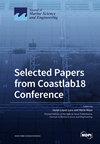亚得里亚海近期和沉没的通博洛斯独特现象
IF 2.8
3区 地球科学
Q1 ENGINEERING, MARINE
引用次数: 0
摘要
普尔维奇岛(亚得里亚海东北航道的克瓦尔纳地区)是 "自然 2000 "保护区网络的一部分。普尔维奇岛西南海岸有一个新近发现的古墓,南面的浅滩上有更大的沉没古墓。这两种现象都是亚得里亚海克罗地亚海岸独有的。使用无人驾驶飞行器对墓陵的内陆部分进行了勘测,并使用多视角立体摄影测量法的运动结构创建了三维点云。墓道后方的滑石角砾岩体呈三角形。大型坍塌岩块构成了海角顶点。该海角在目前的海洋条件下处于平衡状态,但可能会因预测的海平面上升而受到侵蚀。利用潜水设备和遥控潜水器对海底区域进行了勘探。一个巨大的三角形浅滩由飞沙组成。平行垂直的砂岩层看起来像人工建造的墙壁,长达一百多米。碳酸盐角砾岩位于浅滩区的末端。水下浅滩最终形成的条件是在全新世海平面停滞时期创造的。本文章由计算机程序翻译,如有差异,请以英文原文为准。
The Recent and Submerged Tombolos—Unique Phenomena on the Adriatic Sea
Prvić Island (Kvarner area in the NE channel part of the Adriatic Sea) is a part of the Natura 2000 protected area network. A recent tombolo is located on the SW coast of Prvić Island, and much larger submerged tombolos are located on the shoal towards the south. Both phenomena are unique to the Croatian coast of the Adriatic Sea. The inland part of the tombolo was surveyed using an Unmanned Aerial Vehicle, and a 3D point cloud was created using Structure from Motion with Multi-View Stereo photogrammetry. The body of the talus breccia behind the tombolo has a triangular form. Large collapsed rocky blocks form the cape vertex. This cape is in a state of equilibrium in the present oceanographic conditions but might be eroded due to predicted rises in sea level. The submarine zone was explored using scuba-diving equipment and Remotely Operated Vehicles. A large triangle-shaped shoal consists of flysch. Parallel vertical sandstone layers that look like artificially built walls are more than a hundred metres long. The carbonate breccia is located at the end of the shallow zone. The conditions for the final formation of the submerged shoal were created during the sea level stagnation in the Holocene.
求助全文
通过发布文献求助,成功后即可免费获取论文全文。
去求助
来源期刊

Journal of Marine Science and Engineering
Engineering-Ocean Engineering
CiteScore
4.40
自引率
20.70%
发文量
1640
审稿时长
18.09 days
期刊介绍:
Journal of Marine Science and Engineering (JMSE; ISSN 2077-1312) is an international, peer-reviewed open access journal which provides an advanced forum for studies related to marine science and engineering. It publishes reviews, research papers and communications. Our aim is to encourage scientists to publish their experimental and theoretical results in as much detail as possible. There is no restriction on the length of the papers. The full experimental details must be provided so that the results can be reproduced. Electronic files and software regarding the full details of the calculation or experimental procedure, if unable to be published in a normal way, can be deposited as supplementary electronic material.
 求助内容:
求助内容: 应助结果提醒方式:
应助结果提醒方式:


